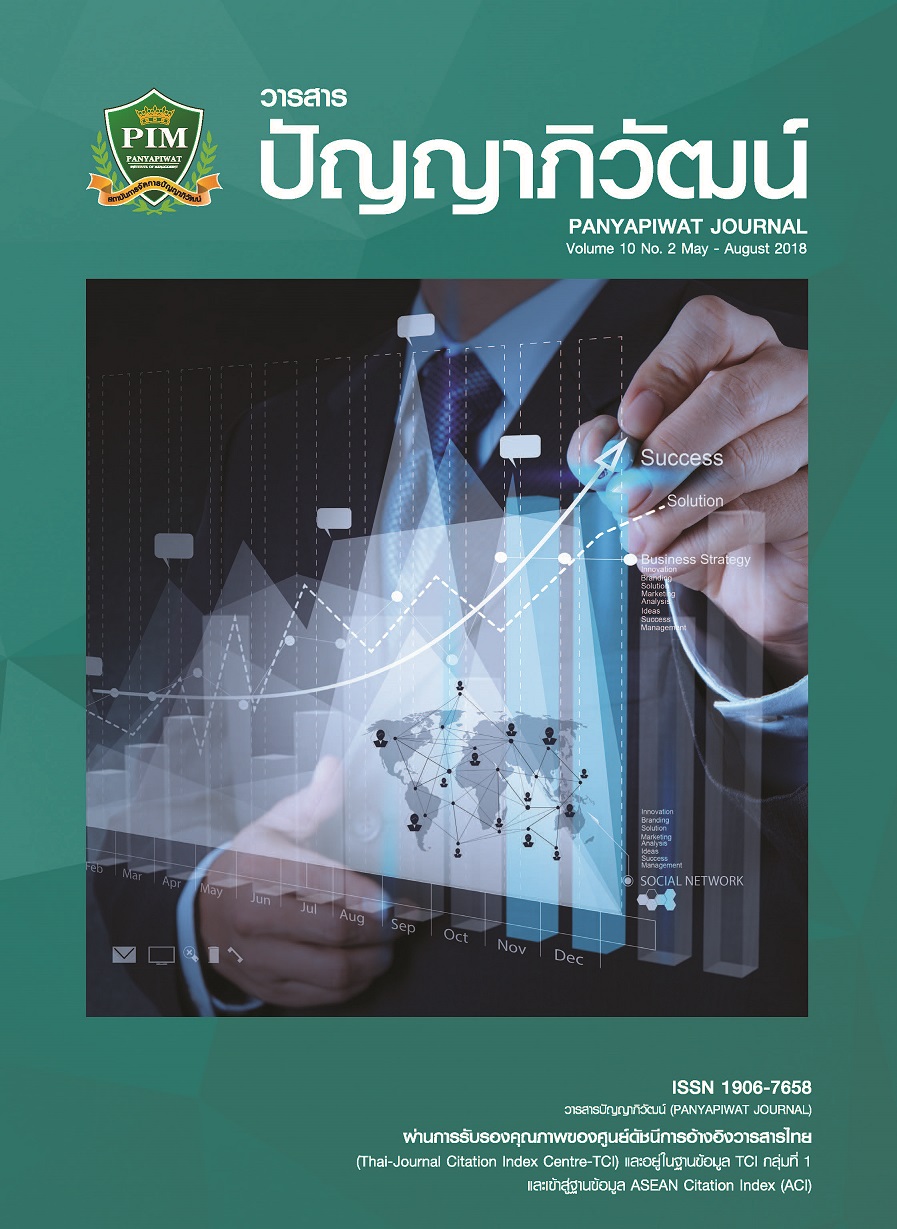การเตรียมความพร้อมของสตรีด้านสุขภาพก่อนเข้าสู่วัยสูงอายุ
Main Article Content
บทคัดย่อ
การศึกษาครั้งนี้เป็นการศึกษาเชิงปริมาณ มีวัตถุประสงค์เพื่อศึกษาสถานการณ์การเตรียมความพร้อมของสตรีในด้านสุขภาพก่อนเข้าสู่วัยสูงอายุ โดยใช้ข้อมูลจาก “โครงการการสำรวจประชากรสูงอายุของประเทศไทย พ.ศ. 2557” ของสำนักงานสถิติแห่งชาติ ประชากรเป้าหมายคือ ผู้ที่มีอายุตั้งแต่ 50 ปีขึ้นไป เลือกเฉพาะผู้ตอบแบบสอบถามด้วยตนเองเท่านั้น จำนวน 9,344 คน และทำการวิเคราะห์ลักษณะทั่วไปของกลุ่มตัวอย่าง และการเตรียมความพร้อมด้านสุขภาพจะใช้สถิติเชิงพรรณนา (Descriptive Statistics)
ผลการศึกษาพบว่า ตัวอย่างมีอายุเฉลี่ย 55 ปี ส่วนใหญ่มีสถานภาพสมรส ร้อยละ 82.30 นับถือศาสนาพุทธ ร้อยละ 96.10 การศึกษาอยู่ในระดับประถมศึกษาหรือต่ำกว่า ร้อยละ 76.01 มีบุตรเฉลี่ย 3 คน และมีสัมพันธภาพในครัวเรือน โดยแบ่งออกเป็น 3 ส่วน คือ 1) การเยี่ยมเยือนจากบุตรอย่างน้อยปีละ 1 ครั้ง คิดเป็นร้อยละ 38.95 2) การพูดคุยทางโทรศัพท์ในครัวเรือนทุกวัน คิดเป็นร้อยละ 38.45 และ 3) ไม่มีการติดต่อผ่านระบบอินเทอร์เน็ต คิดเป็นร้อยละ 94.11 รายได้เฉลี่ยต่อปี 30,000-59,999 บาท ร้อยละ 32.62 มีรายได้จากการทำงาน ร้อยละ 84.79 มีความพึงพอใจในภาวะการเงินของตนเอง ร้อยละ 77.30 ไม่มีความต้องการในการทำงานต่อไปในอนาคต ร้อยละ 49.22 มีภาวะสุขภาพอยู่ในระดับดี ร้อยละ 62.55 และมีการตรวจสุขภาพประจำปีจากสถานบริการของรัฐ ร้อยละ 51.74
การเตรียมความพร้อมด้านสุขภาพพบว่า สตรีเกือบทั้งหมดปฏิบัติได้เหมาะสมมากที่สุดคือ การไม่สูบบุหรี่ พฤติกรรมการออกกำลังกาย ยังพบว่า มีสตรีถึงร้อยละ 15.55 ที่ไม่ออกกำลังกาย สตรีดื่มน้ำสะอาดไม่ถึง 8 แก้วต่อวัน หรือดื่มเป็นบางครั้งถึงร้อยละ 28.18 และสตรีกินผักผลไม้เป็นบางครั้ง ร้อยละ 26.16 ซึ่งอาจเป็นเพราะไม่มีเวลา หรือสุขภาพไม่เอื้ออำนวย โดยเฉพาะผู้ที่มีรายได้น้อยส่วนใหญ่จะไม่มีเวลา ต้องทำงานหนัก และไม่มีเวลาเพียงพอที่จะดูแลสุขภาพหรือเลือกรับประทานอาหารที่มีประโยชน์ จึงทำให้ความสนใจต่อการดูแลสุขภาพลดลง ดังนั้นสตรีที่ไม่ได้มีการเตรียมความพร้อมจึงควรได้รับการส่งเสริมสุขภาพและได้รับการกระตุ้นเตือนหรือรณรงค์เพื่อให้มีสุขภาพหรือมีการเตรียมความพร้อมด้านสุขภาพที่ดีต่อไป
Article Details
“ข้าพเจ้าและผู้เขียนร่วม (ถ้ามี) ขอรับรองว่า บทความที่เสนอมานี้ยังไม่เคยได้รับการตีพิมพ์และไม่ได้อยู่ระหว่างกระบวนการพิจารณาลงตีพิมพ์ในวารสารหรือแหล่งเผยแพร่อื่นใด ข้าพเจ้าและผู้เขียนร่วมยอมรับหลักเกณฑ์การพิจารณาต้นฉบับ ทั้งยินยอมให้กองบรรณาธิการมีสิทธิ์พิจารณาและตรวจแก้ต้นฉบับได้ตามที่เห็นสมควร พร้อมนี้ขอมอบลิขสิทธิ์บทความที่ได้รับการตีพิมพ์ให้แก่สถาบันการจัดการปัญญาภิวัฒน์หากมีการฟ้องร้องเรื่องการละเมิดลิขสิทธิ์เกี่ยวกับภาพ กราฟ ข้อความส่วนใดส่วนหนึ่งและ/หรือข้อคิดเห็นที่ปรากฏในบทความข้าพเจ้าและผู้เขียนร่วมยินยอมรับผิดชอบแต่เพียงฝ่ายเดียว”
References
Berkman, B. & Harootyan, L. (2003). Social Work and Health Care in Aging Society: Education, Policy, Practice, and Research. New York: Springer.
Boonyakawee, C. (2007). The Functional Disability of the Elderly in TambonKrabi-noi Muang District, Krabi Province, Thailand. Public Health Thesis. College of Public Health Science, Chulalongkorn University. [in Thai]
Bootsma-van der Wiel, A., de Craen, A. J., Exel, E. V., Macfarlane, P. W., Gussekloo, J. & Westendorp, R. (2005). Association between chronic diseases and disability in elderly subjects with low and high income: the Leiden 85-plus study. European Journal of Public Health, 15(5), 494-497.
Casado, R. L. (2006). Gender different in association between disability and mortality in the elderly. Doctoral Thesis, Health and Life Sciences Faculty, Pompeu University.
Institute of Geriatric Medicine. (2010). Elderly Situation Report 2010. Bangkok. [in Thai]
Jagger, C., Mathews, R. J., Mathews, F. E. & Spier, N. A. (2006). Cohort difference in disease and disability in young-old: finding from MRC Cognitive Function and Aging Study (MRC-CFAS). BMC Public Health, 7, 156-167.
Jitapunkul, S. (1997). The health survey of older persons. In the health survey of population from the second of physical examination (1996-1997). (p.83-117). Bangkok: Strategy and Planning Division Ministry of Public Health. [in Thai]
Jitapunkul, S. (2000). Chronic Disease and Disability Proliferation in Thai Population: Assumptions Based on Research Data in the Elderly Population. Journal of Gerontology and Geriatric Medicine, 3(2), 42-49. [in Thai]
Krungkrai, N. (1997). Disability status among elderly living in central region of Thailand. The Master Degree in Faculty of Medicine, Chulalongkorn University. [in Thai]
Lima, M. G., Barros, M. B., Cesar, C. L., Goldbaum, M., Carandina, L. & Ciconelli, R. M. (2009). Impact of Chronic Disease on Quality of Life Among the Elderly in the State of Sao Paulo, Brazil: A Population-Based Study. Pan Am J Public Health, 25(4), 314-321.
Murtagh, K. N., Helen, M. A. & Hubert, H. B. (2004). Gender Differences in Physical Disability Among an Elderly Cohort. American Journal of Public Health, 94, 1406-1411.
National Statistical Office. (2014). Thai Elderly Mental Health Report. Bangkok. [in Thai].
Promotion and Elderly Care Ministry of Social Development and Human Security. (2013). Report of the Study on Monitoring and Evaluation Project of the National Elderly Plan No. 2 (2011-2021) Phase 2 (2007-2011). College of Population Studies, Chulalongkorn University. [in Thai]
Songsraboon, R. (2014). Model of Health Care Service Affecting the Satisfaction of Patient in Internal Medicine Department Selected Private Hospitals. Sipakorn University Journal, 34(3), 151-170. [in Thai]
Stuck, A. E., Walthert, J. M., Nicholaus, T., Bula, C. J., Hohmann, C. & Beck, J. C. (1999). Risk for functional status decline in community-living elderly people: A systematic review. SocSci Med, 48(4), 445-69.
Suwannarooji, D. (2013). Determinant Factors of Disability Between Female and Male Elderly in Thailand. The degree of doctor of demography, College of Population Studies, Chulalongkorn University. [in Thai]
Udry, J. R. (1994). The Nature of Gender. Demography, 31(4), 561-573.
Yotsena, B (2016).Quality of Population Acceptance of Globalization and Value of Older person. The degree of doctor of demography, College of Population Studies, Chulalongkorn University. [in Thai]
Yount, K. M. & Agree, E. M. (2005). Differences in Disability among Older Women and Men in Egypt and Tunisia. Demography, 42(1), 169-87.

